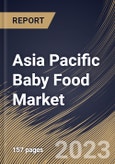Companies are putting money into making homemade baby meals and lactose-free food because every child is different and has different allergies and intolerances to other kinds of products. Doctors recommend food with a single-ingredient formula that doesn't have any sugar or salt for babies around six months old. So, the desire for products that doesn't have any added preservatives is growing very quickly. Big players are focusing on making products that don't have added preservatives, lactose, or gluten to meet the rising demand.
A few prominent trends that contribute to the demand for products are that it is easy to switch to other brands or products and comes in many shapes and flavours. According to the Centres for Disease Control and Prevention (CDC) nutrition guide for infants and toddlers, baby food or infant formula can be given to a child between the ages of 6 and 24 months. Eating more of these products also helps the brain, nervous system, and muscles grow. Many healthcare and paediatric guidelines also state that introducing possibly allergenic foods to babies, like peanuts, cow's milk products, eggs, wheat, etc., might lower the chances of them having allergies to these things.
As more Chinese families experience rising income levels, there is a notable shift in consumer spending patterns, with an increased willingness to invest in premium and specialized products. The higher disposable incomes contribute to an expanding middle class that strongly emphasizes providing their infants with quality nutrition, driving the demand for a diverse range of options. . Parents are more likely to explore and choose products that offer additional benefits, such as organic ingredients, nutritional fortification, and specialized formulations, contributing to the overall growth and diversification of the market in these Asian countries.
The China market dominated the Asia Pacific Baby Food Market, By Country in 2022, and would continue to be a dominant market till 2030; thereby, achieving a market value of $12,735.4 million by 2030. The Japan market is registering a CAGR of 5.8% during (2023 - 2030). Additionally, The India market would showcase a CAGR of 7.2% during (2023 - 2030).
Based on Category, the market is segmented into Conventional, and Organic. Based on Product Type, the market is segmented into Milk formula, Dried Baby Food, Prepared Baby Food, and Others. Based on Distribution Channel, the market is segmented into Supermarkets/Hypermarkets, Drugstores/Pharmacies, Online Channels, and Others. Based on countries, the market is segmented into China, Japan, India, South Korea, Taiwan, Malaysia, and Rest of Asia Pacific.
The market research report covers the analysis of key stake holders of the market. Key companies profiled in the report include Asahi Group Holdings Ltd., Perrigo Company PLC, Nestle S.A, Danone S.A., The Hain Celestial Group, Inc., Royal FrieslandCampina N.V., Sun-Maid Growers of California, Bristol Myers Squibb Company, Hero Group, and Bellamy’s Organic LLC
Scope of the Study
Market Segments Covered in the Report:
By Category (Volume, Kilo Tonnes, USD Billion, 2019 to 2030)- Conventional
- Organic
- Milk formula
- Dried Baby Food
- Prepared Baby Food
- Others
- Supermarkets/Hypermarkets
- Drugstores/Pharmacies
- Online Channels
- Others
- China
- Japan
- India
- South Korea
- Taiwan
- Malaysia
- Rest of Asia Pacific
Key Market Players
List of Companies Profiled in the Report:
- Asahi Group Holdings Ltd.
- Perrigo Company PLC
- Nestle S.A.
- Danone S.A.
- The Hain Celestial Group, Inc.
- Royal FrieslandCampina N.V.
- Sun-Maid Growers of California
- Bristol Myers Squibb Company
- Hero Group
- Bellamy’s Organic LLC
Unique Offerings
- Exhaustive coverage
- The highest number of Market tables and figures
- Subscription-based model available
- Guaranteed best price
- Assured post sales research support with 10% customization free
Table of Contents
Companies Mentioned
- Asahi Group Holdings Ltd.
- Perrigo Company PLC
- Nestle S.A.
- Danone S.A.
- The Hain Celestial Group, Inc.
- Royal FrieslandCampina N.V.
- Sun-Maid Growers of California
- Bristol Myers Squibb Company
- Hero Group
- Bellamy’s Organic LLC








